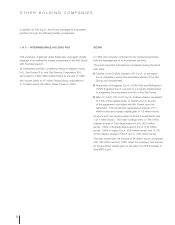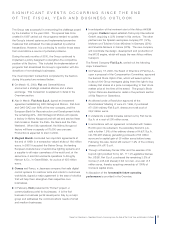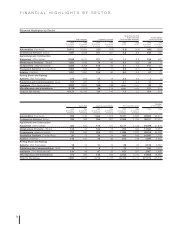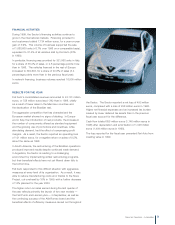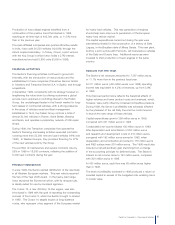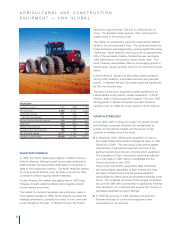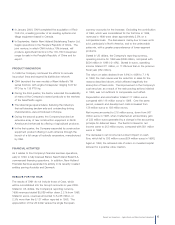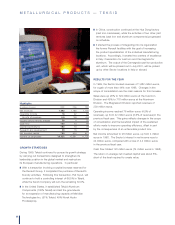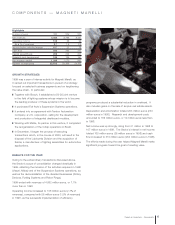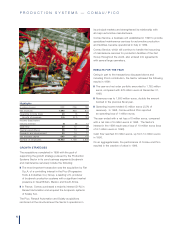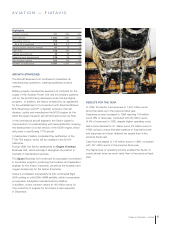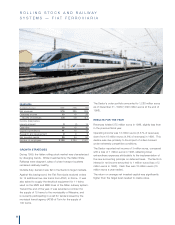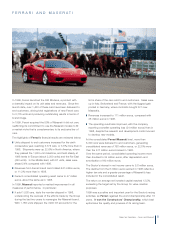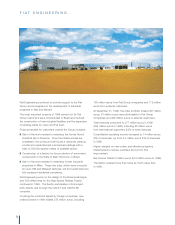Chrysler 1999 Annual Report Download - page 43
Download and view the complete annual report
Please find page 43 of the 1999 Chrysler annual report below. You can navigate through the pages in the report by either clicking on the pages listed below, or by using the keyword search tool below to find specific information within the annual report.
42
SALES PERFORMANCE
In 1999, the tractor market grew slightly in Western Europe.
In North America, although overall tractor sales evidenced a
small increase, this was entirely attributable to the growth in
sales of low horsepower tractors. The North American market
for more powerful tractors, such as those produces by CNH,
continued to reflect ongoing market weakness.
In Latin America, the market was slightly above 1998 levels.
However, drought-related problems had a negative impact
on the industry as a whole.
The market for combine harvesters was particularly weak in
most regions throughout 1999. North America recorded the
weakest performance, primarily as a result of low commodity
prices throughout the year. In Western Europe, the market
declined by approximately 15% due to a difficult year for
crops. The Brazilian market grew by 15%, continuing the
positive trend of the previous year.
The market for construction equipment experienced different
trends in the various product lines. The worldwide market for
loader/backhoes was disappointing, ending significantly below
1998 levels. North America, which accounts for approximately
60% of the worldwide industry, finished the year well below
1998 performance, influenced by rising interest rates. This
trend, however, was partially offset by encouraging growth in
the European market, primarily driven by an improved housing
sector.
In North America, demand for skid-steer loaders remained
strong (+6%), fueled by a favorable economy and suburban
growth. In Western Europe, the market improved significantly,
up 8% over the prior year.
The heavy construction equipment market experienced an
overall decline in all products, except excavators. In North
America, sales of heavy equipment dropped 16% over 1998.
Strong growth in Western European and Latin American
markets could not offset the sharp decline in North America.
GROWTH STRATEGIES
During 1999, CNH continued to support its growth through
both strategic corporate initiatives that strengthened its
position in international markets and the launch of new
products in markets around the world.
❚In November 1999, following the acquisition of Case in
the United States, New Holland changed its name to CNH
Global N.V. (CNH). This new group is the world’s largest
manufacturer of agricultural equipment and one of the
leading international producers of construction equipment.
The acquisition of Case Corporation, which was reflected
on a cost basis in 1999, will be consolidated into the
Group’s accounts in year 2000.
The product line breadth, geographic sales distribution,
and technological capabilities of New Holland and Case
are highly complementary and will provide significant
opportunities for CNH to grow and increase profitability in the
future. The combined resources of the merged companies
also provide CNH with opportunities to significantly enhance
both services to our customers and expand the Company’s
worldwide equipment product offerings.
❚In 1999 the accounts of O&K Orenstein & Koppel AG
(German producer of construction equipment) were
consolidated for the first time.
AGRICULTURAL AND CONSTRUCTION
EQUIPMENT — CNH GLOBAL
Highlights
(in millions of euros) 1999 1998 1997
Net revenues 5,246 5,127 5,284
Operating income 371 452 602
As a % of revenues 7.1 8.8 11.4
Income before minority interest 216 507 422
Cash flow 333 624 528
Capital expenditures 178 151 135
Research and development 158 136 113
Net invested capital 5,777 1,123 592
Number of employees 19,049 21,344 19,077


